Intermittent Fasting Triggers Liver Cell Growth in Mice
An intermittent fasting regimen involves only eating during very specific times; these plans may set mealtimes for certain times of the day, or limit caloric intake to certain days of the week. New research has shown that in a mouse model, intermittent fasting promotes the rapid division of liver cells. Liver cells in adults have been thought to divide slowly, or divide quickly only when damage repair is required. But this research has indicated that certain diets may actually trigger liver cell growth. The findings have been reported in eLife.
"One of the most defining characteristics of the adult liver has been that it is fairly stable in terms of cell turnover," noted senior study author Roeland Nusse, Ph.D., a professor at Stanford University. "But we found the turnover of cells in the liver goes up dramatically after several periods of 24-hour fasting followed by refeeding. Interestingly, this type of diet mirrors the natural diet of wild animals and of early humans, before the development of agriculture, when there were periods with scarce or absent food."
These findings have not been replicated in modern humans yet. Nor do they show how the increase in liver cell proliferation affects health or liver function. But it has suggested that liver cell biology is more adaptable than we knew, and seems to react to dietary changes. Other dietary changes might also affect the liver.
The liver detoxifies the blood, and helps convert food we consume into useful materials for the body. The researchers wanted to know how changes in diet might affect the organ since it is so closely related to digestion.
Lab mice can typically can eat whenever they want, and have access to food and water in their cages. But in this study, the researchers removed food access for 24 hours, then gave the mice as much food as they wanted, and the cycle was repeated. The investigators assessed liver cell division after one week of this diet, or after three weeks of the diet. The fasted mice were compared to mice that had not fasted and had eaten as much as desired.
This revealed that liver cell turnover significantly increased right after the mice were given food again, said Nusse. "There were many more new cells than in animals that had been fed on a standard diet. This was very exciting."
In adults, the average liver weighs three pounds and is about two percent of body weight. But in mice, it's about five percent of body weight. To stay healthy, the ratio between liver and body weights normally stays constant. Livers can also regenerate to maintain that ratio when parts of it are damaged or removed. Cell division was increased in the mouse model in this study because of a reduction in the liver-to-body-weight ratio.
There were two biochemical pathways that were found to be associated with the maintenance of liver size in these mice. One is related to FGF, and another to Wnt. Intermittent fasting can trigger the production of FGF, which goes to the liver. There, liver cells are stimulated to divide. The Wnt pathway, however, is not impacted by fasting, said Nusse.
When mice were engineered so the FGF or Wnt signals did not have any effect, intermittent fasting no longer caused liver cells to divide. "This is a very strong indication that you need both these signaling pathways to see this effect of fasting on cell replication," added Nusse.
Now the researchers want to know whether other diets, such as those high in fat, also affect liver cell growth.
This study has been "an exciting observation," said Nusse, who added that people should not start an intermittent fasting plan just yet. "It shows that the idea that the liver is a tissue that turns over slowly should be taken with a grain of salt."
Sources: Stanford University Medical Center, eLife









